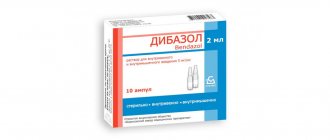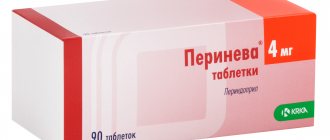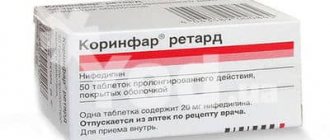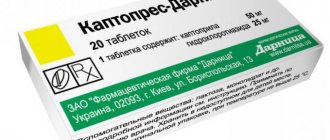Brief information about the drug
The blood pressure medicine Ramilong belongs to the pharmacological group of ACE inhibitor drugs that have a direct effect on the renin-angiotensin system.
Release form
The blood pressure drug Ramilong is presented on the pharmaceutical market in tablet form, which is most convenient for dosing and conducting a therapeutic course at home.
Composition and active substance
The main active component included in the drug is ramipril, presented in dosages of 2.5 mg, 5 mg or 10 mg.
The tablets also include excipients such as starch, microcrystalline cellulose, magnesium stearate, hypromellose, sodium starch glycolate.
Packaging of Ramilong tablets
pharmachologic effect
Ramilong is a drug that has a pronounced antihypertensive effect.
Manufacturer
The medicine Ramilong is produced by the Belarusian pharmaceutical company.
Terms and conditions of storage
The maximum permissible shelf life of tablets is 2 years. It is recommended to store the drug in a dark and dry place, inaccessible to children and pets. The optimal storage temperature should not exceed +25°C.
Terms of sale
You can purchase medication in pharmacy chains upon presentation of an appropriate medical prescription.
Price
The exact cost of the drug depends on the number of tablets in the package and the dose of the main active substance. The average price of Ramilong tablets varies from 4 to 14 Belarusian rubles.
Composition, action and application of Varicobooster cream for varicose veins
There are many factors that can affect health in a negative way. This is the reason for the need for preventive measures to avoid the manifestation of symptoms of various diseases. However, a disturbed environment, sedentary work and excessive stress bring their own unpleasant adjustments to life.
Adding to everything excess weight, a sedentary lifestyle and a genetic predisposition to diseases, we get varicose veins, the fight against which is often impossible without surgical intervention.
Cream-balm “Varicobooster” is the latest development in the field of medicine, restoring youth and former strength to the legs. Being a powerful drug, the product is easy to use and consists of natural ingredients. The benefits of using the cream have already been felt by thousands of people suffering from varicose veins.
What is Varicobooster cream?
The product is available in the form of a cream for external use. One of the positive features of its use is that there is no need to take other medications in parallel, the price of which is not always affordable. The undeniable advantages of Varicobooster also include:
- There is no need to wrap your legs or wear compression stockings after applying the medicine to the body;
- Rapid absorption of the drug, which allows you to put on clothes in a couple of minutes without the risk of greasy stains appearing on them;
- No unpleasant odor characteristic of many other drugs.
Cream composition
The main advantage of the cream is its miraculous, unparalleled formula. The product contains a number of natural components that have a beneficial effect on the diseased areas and the entire body. These are:
- Birch leaves and horse chestnut;
- Troxerutin;
- Honey, caffeine, ginkgo biloba;
- Nettle, wormwood, chamomile, menthol;
- Lemon essential oil, coconut and soybean oils.
How the balm works
Saturated with useful substances necessary to combat varicose veins, the cream has a comprehensive effect on problem areas. After applying the cream composition, its active microelements are absorbed by the skin within a minimum period of time.
The action of chestnut and birch leaves is aimed at strengthening the walls of blood vessels, restoring the structure of the skin, relieving swelling and pain. At the same time, these gifts of nature restore the tone of the legs as effectively as possible.
Troxerutin can relieve night cramps in the calf muscles, eliminate heaviness and pain in the limbs, and reduce the likelihood of worsening the inflammatory process to a minimum.
Thanks to the action of caffeine and honey, tissue metabolism is accelerated, blood microcirculation is stimulated, and cellular metabolism is activated. These components also have a cleansing and toning effect.
Herbal collection of wormwood, chamomile, menthol and nettle is a set of natural components that have a noble effect of a wide spectrum. Elimination of sweating, antiseptic, refreshing and deodorizing effect, increasing the elasticity of blood vessels occurs thanks to these components. The presence of beneficial herbal elements also implies effective healing of cracks, reduction of sweating and fatigue. The effect of oils is saturation of the skin with nutrients and moisturizing, improved blood circulation, and the absence of an unpleasant odor.
How to use the cream-balm
The treatment process with Varicobooster cream is absolutely simple. The essence of the procedures is to apply the balm to problem areas of the legs once a day. It is recommended to avoid simultaneous treatment with third-party drugs.
A course of treatment
The period after which varicose veins will remain a thing of the past depends on a number of factors:
- The degree of neglect of the disease;
- Presence of other diseases;
- General tone of the body.
If you decide to use this cream, then purchase it only on the official website.
Pharmacodynamics and pharmacokinetics
Ramilong blood pressure tablets have hypotensive and vasodilating properties. The drug has a beneficial effect on the condition and functions of the myocardium. It is important that Ramilong reduces pressure smoothly and gently, without increasing the heart rate and without negatively affecting the functioning of the renal apparatus.
The medicine is quickly absorbed by the body, once in the liver area it is transformed into ramiprilat.
The drug belongs to the group of ACE inhibitors
Ramilong lowers blood pressure after 1-2 hours from taking the tablets. The therapeutic effect lasts throughout the day, which avoids the need for frequent medication use.
At the same time, Ramilong is characterized by a cumulative effect. The best results are achieved with a course of tablets. After completing a full therapeutic course of 21 days, you can achieve stabilization of blood pressure for 2 years.
Interaction with other drugs
Shortens the effect of barbiturates, enhances the effect of narcotic analgesics.
Sources
- https://simptomov.com/preparat/kardiologiya/renin-angiotenzin/ramilong/
- https://www.neboleem.net/amilonosar.php
- https://www.webapteka.ru/drugbase/name18614.html
- https://upheart.org/lechenie/tabletki/amilonosar-effektivnoe-uluchshenie-mozgovogo-krovoobrashcheniya.html
- https://pro-acne.ru/sosudy-i-serdtse/amilonosar-instruktsiya-po-primeneniyu-otzyvy-tseny-2.html
- https://NeuroDoc.ru/lekarstva/amilonosar.html
- https://opohmele.ru/lechenie-alkogolizma/amilonosar.html
- https://gipertoniya-med.ru/lekarstva/ramilong.html
- https://VseDavlenie.ru/lekarstva/ingibitory/ramilong-pri-davlenii.html
- https://Cardio-help.ru/aptechka/ramilong-709
When use is contraindicated
Medical specialists prohibit patients with the following clinical contraindications from taking Ramilong if they have high blood pressure:
- Conn's syndrome;
- Hypotonic disease (consistently low blood pressure);
- Renal artery stenosis;
- Individual intolerance and hypersensitivity to substances contained in tablets;
- Pregnancy;
- Breastfeeding period;
- The presence of angioedema in the patient's medical history;
- Carrying out hemodialysis procedures;
- Treatment of nephropathy with non-steroidal anti-inflammatory drugs, angiotensin receptor antagonists, immunomodulators.
This drug is not used for the treatment of children and adolescents under the age of majority.
Ramilong is contraindicated for patients on hemodialysis
Indications for use of "Ramilong"
Indications for the use of this remedy are a number of heart diseases and high blood pressure.
The main indications for the use of this drug are as follows:
- treatment of arterial hypertension (hypertension);
- heart failure (chronic, congestive);
- prevention of complications and malfunctions of the heart muscle in the event of a myocardial infarction;
- nephro- and/or retinopathy in diabetes mellitus;
- a component of anti-ischemic therapy to reduce the risk of stroke or heart attack.
Instructions for use and dosage
Instructions for use of Ramilong recommend taking the tablets in the morning, without first crushing or chewing.
The recommended starting dosage of the drug for arterial hypertension is 2.5 mg per day. If there is no proper antihypertensive effect after 2 weeks of treatment, the daily dose of Ramilong can be increased to 5 mg or 10 mg.
With a sharp decrease in blood pressure, the dosage of the medication is reduced to 1.25 mg per day, and further treatment is carried out under strict medical supervision.
Ramilong tab 5mg No. 10x6
Name
Ramilong.
Release forms
Pills.
INN
Ramipril.
FTG
APF blocker.
Description
Ramilong 2.5 mg: Tablets of white or almost white color, flat-cylindrical in shape, with a bevel. Ramilong 5 mg and 10 mg: Tablets are white or almost white, flat-cylindrical in shape, beveled and scored.
Compound
Each 2.5 mg tablet contains: active substance: ramipril - 2.5 mg. excipients: corn starch (modified Starch 1500), hypromellose, sodium starch glycolate, magnesium stearate, microcrystalline cellulose. Each tablet 5 mg, 10 mg contains: active substance: ramipril - 5 mg or 10 mg. excipients: corn starch (modified Starch 1500), hypromellose, sodium starch glycolate, sodium stearyl fumarate, microcrystalline cellulose.
Pharmacotherapeutic group
Drugs affecting the renin-angiotensin system. Angiotensin-converting enzyme (ACE) inhibitors. ATX code: C09AA05.
Indications for use
— Treatment of arterial hypertension: to lower blood pressure both in monotherapy and in combination with other antihypertensive drugs; — Prevention of cardiovascular disorders: reduction in the number of cardiovascular complications (myocardial infarction, stroke and death) in patients with: — severe atherothrombotic cardiovascular diseases (history of coronary heart disease or stroke, obliterating diseases of the arteries of the lower extremities) or — diabetes mellitus and at least one cardiovascular risk factor (see Pharmacological properties); - Secondary prevention in patients with acute myocardial infarction: reducing the risk of death, starting from the acute phase of myocardial infarction, in patients with clinical signs of heart failure when prescribed 48 hours after the onset of the disease; — Treatment of glomerular kidney diseases: — initial stage of diabetic nephropathy, with the presence of microalbuminuria; - obvious diabetic nephropathy with the presence of macroproteinuria in patients with at least one risk factor for cardiovascular diseases (see Pharmacological properties); - obvious non-diabetic nephropathy with the presence of macroproteinuria ≥ 3 g/day; — Treatment of chronic heart failure.
Directions for use and doses
Ramilong is recommended to be taken daily at the same time of day. The tablets should be taken with or without food (that is, the tablets can be taken before, during or after meals) and with a sufficient amount (1/2 glass) of water. Do not chew or crush the tablets before taking. The dose is selected depending on the therapeutic effect and tolerability of the drug by the patient. This drug does not provide a dosage of 1.25 mg; if it is necessary to use ramipril at a dose of 1.25 mg, it is necessary to use a drug from another manufacturer. Treatment with Ramilong is usually long-term, and its duration in each case is determined by the doctor. An excessive decrease in blood pressure is possible at the beginning of treatment with the drug, especially in patients with low salt and fluid content in the body (for example, vomiting, diarrhea, diuretic treatment), heart failure (especially after acute myocardial infarction) or severe hypertension. Adults Patients treated with diuretics The lack of salts and fluid in the body must be preliminarily corrected before taking ramipril; the diuretic should be limited or discontinued no later than 2-3 days in advance (see Precautions and application details). Treatment of patients who have not discontinued the diuretic should begin with a dose of 1.25 mg. It is necessary to monitor kidney function and serum potassium levels. Subsequent dosage of Ramilong should be adjusted according to target blood pressure levels. Treatment of arterial hypertension The dose is calculated depending on the expected therapeutic effect and tolerability of the drug in each specific case. Ramilong can be used both as monotherapy and in combination with other classes of drugs for the treatment of arterial hypertension. The initial recommended dose of ramipril is 2.5 mg. Patients with a highly activated renin-angiotensin-aldosterone system may experience an excessive decrease in blood pressure after the initial dose. For such patients, the recommended starting dose is 1.25 mg, and initiation of treatment should be under medical supervision. The dose may be doubled at 2-4 week intervals to achieve target blood pressure levels. The maximum permissible daily dose of ramipril is 10 mg. The daily dose is taken once a day. Prevention of cardiovascular disorders The recommended starting dose of ramipril is 2.5 mg once daily. The dose should be increased gradually, depending on the patient's tolerance of the active substance. It is recommended to double the dose after 1-2 weeks of treatment, and after the next 2-3 weeks, increase it to the target maintenance dose of 10 mg ramipril once daily. Secondary prevention in patients after acute myocardial infarction with heart failure 48 hours after myocardial infarction in clinically and hemodynamically stable patients, the initial dose is 2.5 mg twice daily for three days. If the initial dose of 2.5 mg is not tolerated by the patient, a dose of 1.25 mg twice daily should be prescribed for 2 days before increasing the dose to 2.5 mg and 5 mg twice daily. If the dose cannot be increased to 2.5 mg twice daily, treatment should be discontinued. (See also dosage assignments in patients treated with diuretics.) Titration and individual maintenance dose The daily dose is sequentially increased, doubling it at intervals of 1-3 days until the target maintenance dose of 5 mg twice daily is achieved. It is recommended to divide the maintenance daily dose into 2 doses. To date, there is not enough experience in treating patients immediately after myocardial infarction with concomitant severe chronic heart failure (grade IV on the NYHA scale). If a decision is made to prescribe ramipril to such patients, it is recommended to begin treatment with a dose of 1.25 mg once daily, taking particular care when increasing the dose. Treatment of kidney disease In patients with diabetes mellitus and microalbuminuria: The recommended starting dose of ramipril is 1.25 mg once daily. The daily dose is increased depending on the patient's tolerance of the active substance. It is recommended to double the daily dose to 2.5 mg after 2 weeks of treatment, and then to 5 mg after the next 2 weeks. In patients with diabetes mellitus and at least one cardiovascular risk factor. The recommended starting dose of ramipril is 2.5 mg once daily. Depending on the patient’s tolerance of the active substance, the dose is gradually increased: it is recommended to double the daily dose to 5 mg after 1-2 weeks of treatment, and then to 10 mg after the next 2-3 weeks. The maximum daily dose of ramipril is 10 mg. In patients with nondiabetic nephropathy with macroproteinuria ≥ 3 g/day. The recommended starting dose is 1.25 mg ramipril once daily. The daily dose is increased depending on the patient's tolerance of the active substance. It is recommended to double the daily dose to 2.5 mg after 2 weeks of treatment, and then to 5 mg after the next two weeks. Treatment of chronic heart failure In patients receiving diuretic therapy, the recommended initial dose is 1.25 mg per day. Ramilong should be titrated by doubling the dose every two weeks to a maximum daily dose of 10 mg. It is preferable to divide the daily dose into 2 doses. Special groups of patients Patients with impaired renal function The daily dose for patients with impaired renal function is prescribed taking into account creatinine clearance: - if creatinine clearance ≥ 60 ml/min, there is no need to adjust the initial dose (2.5 mg daily), maximum daily dose -10 mg; - if creatinine clearance is in the range of 30-60 ml/min, there is no need to adjust the initial dose (2.5 mg daily), the maximum daily dose is 5 mg; - if creatinine clearance is in the range of 10-30 ml/min, the initial dose is 1.25 mg daily, and the maximum daily dose is 5 mg; - in patients with hypertension undergoing hemodialysis: ramipril is poorly dialyzable; The initial dose is 1.25 mg daily, and the maximum daily dose is 5 mg; the drug must be taken several hours after hemodialysis. Patients with impaired liver function Treatment of such patients should be carried out with extreme caution and only under medical supervision. The maximum permissible daily dose in such cases is 2.5 mg of ramipril. Elderly patients Initial doses should be lower and administered more gradually due to the increased risk of adverse reactions, especially in elderly and debilitated patients. The recommended initial daily dose is 1.25 mg ramipril.
Children
The use of the drug in pediatrics is not recommended due to the lack of sufficient relevant data on the safety and effectiveness of the drug.
Side effect
When treated with ramipril, side effects such as a persistent dry cough and hypotensive reactions may occur. Serious adverse reactions include angioedema, hyperkalemia, deterioration of renal and hepatic function, pancreatitis, some skin reactions and neutropenia/agranulocytosis. The frequency of occurrence of adverse reactions is determined as follows: very common (> 1/10), frequent (> 1/100, 1/1000, 1/10000,
Contraindications
Ramilong is contraindicated in the following cases: - hypersensitivity to the active substance ramipril, other ACE inhibitors and other components of the drug; - patients who, according to anamnestic data, have previously had angioedema (risk of rapid development of angioedema, including while taking ACE inhibitors); - hemodialysis; - hemodynamically significant stenosis of the renal arteries (bilateral, in the case of one kidney - unilateral); - arterial hypotension (systolic blood pressure less than 90 mm Hg) or conditions with unstable hemodynamic parameters; - pregnancy and breastfeeding (see Use during pregnancy and breastfeeding); - age under 18 years (efficacy and safety have not been established); - in combination with drugs containing Aliskiren, in patients with diabetes mellitus (type I or II) or with moderate to severe renal failure (glomerular filtration rate less than 60 ml/min/1.73 m2); - nephropathy, treated with glucocorticosteroids, non-steroidal anti-inflammatory drugs, immunomodulators and/or other cytotoxic drugs; - simultaneous use with angiotensin II receptor antagonists (AIIRAs) in patients with diabetic nephropathy.
Use during pregnancy and breastfeeding
The use of the drug is not recommended in the first trimester of pregnancy. The use of the drug is contraindicated in the second and third trimester of pregnancy. Pregnancy Epidemiological data on the risk of teratogenicity when taking ACE inhibitors in the first trimester of pregnancy do not allow a final conclusion, but a slight increase in risk cannot be excluded. Except in cases where it is not possible to replace an ACEI with another alternative therapy, patients planning pregnancy should be switched to antihypertensive therapy with drugs that have a well-studied safety profile for pregnant women. If pregnancy occurs, the ACE inhibitor should be discontinued immediately and, if necessary, other antihypertensive therapy should be prescribed. When using ACE inhibitors in the second and third trimesters of pregnancy, fetotoxic effects (impaired renal function, oligohydramniosis, delayed ossification of the skull bones) and neonatal toxicity (renal failure, hypotension, hyperkalemia) have been established. If an ACE inhibitor has been taken since the second trimester of pregnancy, an ultrasound examination of the function of the kidneys and skull bones is recommended. In newborns whose mothers took ACE inhibitors, blood pressure should be carefully monitored to prevent the possible development of hypotension. Breastfeeding period It is not recommended to prescribe ramipril during breastfeeding due to lack of information. It is advisable to give preference to other medications, the use of which is safer during breastfeeding.
Precautions and application features
Treatment with ramipril is usually long-term, its duration in each case is determined by the doctor. It also requires regular medical supervision, in particular in patients with impaired liver and kidney function. It is usually recommended to correct dehydration, hypovolemia or salt deficiency before starting treatment. If absolutely necessary, treatment with the drug can be started or continued only if appropriate precautions are taken at the same time to prevent an excessive decrease in blood pressure and impaired renal function. Special categories of patients Monitoring of renal function Monitoring of renal function is necessary, especially during the first weeks of treatment. Patients suffering from renal vascular disease (for example, with renal artery stenosis not yet clinically significant, or with unilateral hemodynamically significant renal artery stenosis), in cases of pre-existing renal impairment, as well as in patients who have undergone a kidney transplant, require particularly careful monitoring . Hyperkalemia Serum potassium and sodium concentrations should be regularly monitored. In patients with impaired renal function, more frequent monitoring of their concentrations in the blood serum is required. It is necessary to monitor the number of leukocytes in order to quickly diagnose leukopenia. Hyperkalemia has been observed in some patients taking ACE inhibitors, including ramipril. Patients at increased risk of developing hyperkalemia include patients with renal failure, elderly patients (over 70 years of age), patients with uncontrolled diabetes mellitus, or patients taking potassium salts, potassium-sparing diuretics and other active substances that increase plasma potassium levels blood, as well as patients with conditions such as dehydration, acute heart failure or metabolic acidosis. If the simultaneous use of the above-mentioned drugs is considered appropriate, then regular monitoring of serum potassium levels is recommended. Neutropenia/agranulocytosis If signs of immunocompromise due to leukopenia appear (for example, fever, swollen lymph nodes, tonsillitis), urgent monitoring of the peripheral blood picture is necessary. If signs of bleeding appear (tiny petechiae, red-brown rashes on the skin and mucous membranes), monitoring the number of platelets in the peripheral blood is also necessary. Before and during treatment, it is necessary to monitor blood pressure, kidney function, hemoglobin levels in peripheral blood, creatinine, urea, electrolyte concentrations and the activity of liver enzymes in the blood. Caution must be exercised when prescribing the drug to patients on a low-salt or salt-free diet (increased risk of developing arterial hypotension). Patients at risk of hypotension - Patients with increased activity of the renin-angiotensin-aldosterone system Patients with increased activity of the renin-angiotensin-aldosterone system are at risk of a sharp drop in blood pressure and deterioration of renal function during ACE inhibition, especially at the beginning of treatment or at the first dose increase ACE inhibitors or concomitantly taken diuretics. Possible manifestations of increased activity of the renin-angiotensin-aldosterone system must be taken into account by carrying out constant medical supervision, including blood pressure monitoring, in cases, for example: - patients with severe hypertension; — patients with decompensated congestive heart failure; - patients with clinically significant hemodynamic disorders (inflow and outflow) in the left ventricle (for example, aortic stenosis, mitral stenosis); — patients with unilateral renal artery stenosis with a second functional kidney; - patients with electrolyte and (or) fluid deficiency (including patients previously treated with diuretics); — patients with liver cirrhosis and/or ascites; - patients undergoing major surgery or during anesthesia with agents that cause hypotension. Before initiating treatment, it is recommended to correct dehydration, hypovolemia, or electrolyte deficiency (in patients with heart failure, such adjustments should be weighed against the risk of volume excess). — Transient or permanent heart failure after myocardial infarction. - Patients at risk of cardiac or cerebral ischemia due to acute hypotension. Transient arterial hypotension is not a contraindication for continuing treatment after stabilization of blood pressure. If severe arterial hypotension reoccurs, the dose should be reduced or the drug discontinued. If there is a history of angioedema not associated with taking ACE inhibitors, then such patients still have an increased risk of developing it when taking Ramilong. Dual blockade of the renin-angiotensin-aldosterone system Dual blockade of the renin-angiotensin-aldosterone system is associated with an increased risk of hypotension, hyperkalemia and renal dysfunction (including acute renal failure) compared with monotherapy. Dual blockade of the RAAS using ACE inhibitors, AT II receptor blockers (ARBs), or Aliskiren cannot be recommended in any patient, especially in patients with diabetic nephropathy. In some cases, when the combined use of ACE inhibitors and ARB II is absolutely indicated, careful supervision by a specialist and mandatory monitoring of renal function, water and electrolyte balance, and blood pressure are necessary. This applies to the use of candesartan or valsartan as adjunctive therapy to ACE inhibitors in patients with chronic heart failure. Carrying out double blockade of the RAAS under the careful supervision of a specialist and mandatory monitoring of renal function, water-electrolyte balance and blood pressure is possible in patients with chronic heart failure with intolerance to aldosterone antagonists (spironolactone), who have persistence of symptoms of chronic heart failure, despite other measures adequate therapy. During the treatment period, it is necessary to refrain from engaging in potentially hazardous activities that require increased concentration and speed of psychomotor reactions, because Dizziness is possible, especially after the initial dose of an ACE inhibitor in patients taking diuretics. Caution should be exercised when performing physical exercise or hot weather due to the risk of dehydration and hypotension due to decreased fluid volume. It is not recommended to consume ethanol. Surgery Treatment with ACE inhibitors such as ramipril should, if possible, be discontinued one day before planned surgery. Angioedema Angioedema of the tongue, pharynx, or larynx (possible symptoms: difficulty swallowing or breathing) can be life-threatening and require emergency treatment. After taking the first dose, as well as when increasing the dosage of a diuretic and/or ramipril, patients should be under medical supervision for 8 hours to avoid the development of an uncontrolled hypotensive reaction. In patients with chronic heart failure, taking the drug can lead to the development of severe arterial hypotension, which in some cases is accompanied by oliguria or azotemia and rarely by the development of acute renal failure. Patients with malignant arterial hypertension or concomitant severe heart failure should begin treatment in a hospital setting. Anaphylactic reactions When using ACE inhibitors (see also membrane manufacturer's instructions), life-threatening, rapidly developing, allergy-like (anaphylactoid) hypersensitivity reactions, sometimes leading to shock, have been described in patients undergoing hemodialysis using certain high-flux membranes (eg , polyacrylonitrile membranes). It is necessary to avoid the combined use of Ramilong and this type of membrane, for example, for urgent hemodialysis or hemofiltration. In this case, it is preferable to use other membranes or avoid taking ACE inhibitors. Similar reactions were observed during low-density lipoprotein apheresis using dextran sulfate. Therefore, this method should not be used for patients treated with ACE inhibitors. When taking ACE inhibitors, the likelihood and severity of anaphylactic and anaphylactoid reactions to insect venom and other allergens increases. Temporary discontinuation of ramipril should be considered before desensitization. Cough Cough has been reported during treatment with ACE inhibitors. The cough is nonproductive, persistent and occurs after discontinuation of therapy. When making a differential diagnosis of cough in a patient, the possibility of its association with the use of ACE inhibitors should be taken into account. Ethnic differences ACE inhibitors are associated with an increased incidence of angioedema in black patients compared to patients of other skin color. Like other ACE inhibitors, ramipril may be less effective in lowering blood pressure in black patients compared to patients of other skin color. This may be due to the high prevalence of low-renin hypertension in the black hypertensive population.
Overdose
Symptoms: marked decrease in blood pressure, shock, severe bradycardia, water and electrolyte imbalance, acute renal failure, stupor. Treatment: gastric lavage, taking adsorbents, sodium sulfate (if possible within the first 30 minutes). In case of arterial hypotension, the administration of alpha-1-adrenergic agonists (norepinephrine, dopamine) and angiotensin-II (angiotensinamide) can be added to therapy to replenish circulating blood volume and restore salt balance. Ramiprilat, the active metabolite of ramipril, is almost not dialyzed.
Interaction with other drugs
Not recommended combinations: - potassium salts, potassium-sparing diuretics (for example, amiloride, triamterene, spironolactone): simultaneous use leads to hyperkalemia (monitoring of serum potassium is necessary); - antihypertensive drugs (in particular, diuretics) and other drugs that lower blood pressure: simultaneous use leads to increased effects of ramipril; - sleeping pills, narcotics and painkillers: can cause a sharp decrease in blood pressure; - vasopressor sympathomimetic drugs (epinephrine) and estrogens may weaken the effect of ramipril; - allopurinol, procainamide, cytostatic agents, immunosuppressants, systemic corticosteroids and other drugs that can change the blood picture, in particular, reduce the number of leukocytes in the blood; — lithium: an increase in the concentration of serum lithium and, as a result, an increase in the cardio- and neurotic effects of lithium; - oral hypoglycemic agents (sulfonylurea derivatives, biguanides), insulin: increased hypoglycemia; - non-steroidal anti-inflammatory drugs (indomethacin, acetylsalicylic acid): the effect of ramipril may be weakened; - heparin: possible increase in serum potassium concentration; - table salt: weakening the effect of ramipril; - alcohol: enhances the hypotensive effect of ramipril. - Dual blockade of the RAAS using ACE inhibitors, AT II receptor blockers (ARBs) or Aliskiren cannot be recommended for any patient, especially patients with diabetic nephropathy. In patients with diabetes mellitus or moderate/severe renal impairment (GFR
Impact on the ability to drive vehicles or potentially dangerous mechanisms
Some adverse reactions (symptoms of low blood pressure such as heaviness, dizziness) may reduce the patient's reaction and concentration, which may affect his ability to drive a car and use machinery. This is most likely to occur at the beginning of treatment, during dose increases, drug changes, and during interactions with alcohol. It is not recommended to drive or operate machinery for several hours after taking the first dose or increasing the dose.
Storage conditions
In a place protected from moisture and light at a temperature not exceeding 25 °C. Keep out of the reach of children.
Best before date
2 years. Do not use after the expiration date stated on the packaging. Conditions of release By prescription.
Package
Dosage 2.5 mg: 10 tablets in a blister pack made of polymer film and aluminum foil. Three blister packs each along with instructions for medical use in a cardboard pack. Dosage 5 mg or 10 mg: 10 tablets in a blister pack made of polyvinyl chloride film and aluminum foil. Three or six blister packs along with instructions for medical use in a cardboard pack.
Buy Ramilong tablet 5 mg in container pack No. 10x6 in the pharmacy
Price for Ramilong tablet 5 mg in container pack No. 10x6
Instructions for use for Ramilong tablet 5 mg in container pack No. 10x6
Adverse reactions
Treatment with Ramilong may cause the following side effects:
- A sharp decrease in blood pressure;
- Nausea and vomiting;
- Depressive states;
- Headache;
- Allergic rashes on the skin like urticaria;
- Stool disorders (constipation or diarrhea syndrome).
You must notify your doctor about any adverse reactions that occur during the therapeutic course! To solve the problem, you may need to reduce the daily dose of the drug or select a more suitable substitute!
Headache may be a side effect
Adverse events
Among the side effects of the drug "Ramilonga" the following pathological conditions are distinguished:
- dry cough;
- headache, dizziness, weakness, sleep disturbance;
- excessive decrease in blood pressure (hypotension);
- allergic reactions, including rash and angioedema;
- increased potassium levels in the blood;
- angina pectoris, arrhythmic disorders;
- increased heart rate (tachycardia);
- threat of stroke;
- rarely - acute renal failure;
- the appearance of large concentrations of protein in the urine (proteinuria);
- nausea, vomiting, possible changes in taste;
- anemia, thrombocytopenia (decreased platelet count), neutropenia;
- convulsions, tremor, paresthesia.
Drug overdose
The use of Ramilong tablets in excessively large dosages can cause the following alarming clinical symptoms:
- Violation of water and electrolyte balance in the patient’s body;
- Slow heart rate, severe bradycardia;
- Excessive and sharp decrease in blood pressure, up to the development of a hypotensive crisis;
- State of shock;
- Falling into a stupor.
In case of such a clinical picture, it is necessary to call an ambulance, and before the doctors arrive, provide the victim with first aid by performing a gastric lavage and giving a portion of sorbents. Further treatment of overdose with Ramilong is symptomatic and is prescribed by medical specialists on an individual basis.
Specific features of use
During the period of taking the drug "Ramilong", it is necessary to constantly monitor the level of blood pressure, as well as certain blood parameters: the level of leukocytes and hemoglobin. In addition, electrolyte balance and indicators of adequate kidney function should be constantly monitored. This drug is prescribed with caution to people who are employed in jobs that require significant concentration and quick reactions. Ramilong is prescribed with extreme caution to patients with liver and/or kidney pathologies. After taking this drug for the first time, the patient should spend several hours under medical supervision.
It is not recommended to prescribe Ramilong simultaneously with potassium preparations and potassium-sparing diuretics, since in this situation the risk of developing hyperkalemia increases. It is also not recommended to additionally prescribe other drugs that reduce blood pressure due to the possible risk of severe hypotension (hypotension). Simultaneous use of drugs based on allopurinol, cytostatics and immunosuppressants increases the risk of developing leukopenia. The activity of Ramilong is reduced in case of simultaneous administration of non-steroidal anti-inflammatory drugs.
Pharmacological compatibility
The combination of tablets with non-steroidal anti-inflammatory drugs significantly reduces the hypotensive effect of Ramilong and the effectiveness of the therapeutic course.
Combination with diuretics and drugs containing potassium threatens the development of hyperkalemia. Also, potassium levels in the blood increase when ACE inhibitors are combined with Heparin.
With the simultaneous use of Ramilong with other antihypertensive medications, the risks of a decrease in blood pressure to critical levels and the development of a hypotensive crisis increase many times over. A similar effect is observed when combined with alcohol-containing drugs and alcoholic beverages. In addition, ethanol contributes to a more pronounced manifestation of side effects characteristic of Ramilong and increases the likelihood of developing a drug overdose.
It is strictly contraindicated to combine these blood pressure pills with hypoglycemic drugs.
During the therapeutic course, medical experts also recommend paying special attention to nutrition and limiting the percentage of salt in the daily diet as much as possible, and it is advisable to completely exclude it from the daily menu to increase the effectiveness of treatment.
Ramilong may be incompatible with other drugs
Contraindications for use
"Ramilong" should not be prescribed in the following situations:
- individual sensitivity to ACE inhibitors and ramipril, in particular, as well as to other medicinal components;
- tendency to the appearance of angioedema;
- narrowing of the renal arteries;
- severe kidney failure;
- stenosis (narrowing of the lumen) of the aorta, mitral or aortic valve;
- hypertrophic cardiomyopathy;
- severe anemia;
- a significant increase in potassium levels in the blood (hyperkalemia);
- age up to 18 years.
Analogues and substitutes
On the modern pharmaceutical market you can find and purchase the following substitutes, analogues of Ramilong:
- Ramilong Plus;
- Hartil;
- Ramimed;
- Ampril;
- Tritace.
It should be noted that with the exception of the drug Ramilong Plus, which is an absolute analogue of Ramilong, other medications have their own specific characteristics, contraindications, and side effects. For this reason, it is strictly not recommended to independently replace the blood pressure pills prescribed by the doctor with any of their analogues. If you need to select a substitute, you should seek help from a qualified specialist who will find the best option and explain how and in what dosage to take the medicine!
Ramilong for high blood pressure is an effective antihypertensive drug that not only normalizes tonometer readings, but also stabilizes them for a long time. In addition, the tablets have a beneficial effect on the heart and blood vessels, reducing the likelihood of developing, progressing, cardiac diseases. However, due to a number of restrictions on use, the drug can only be used as prescribed by a doctor, strictly observing the dosage and duration of the therapeutic course recommended by a specialist!









